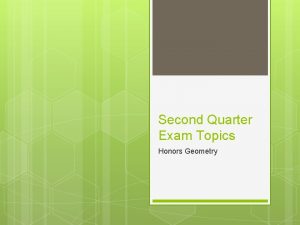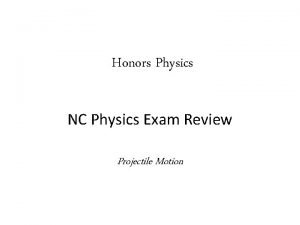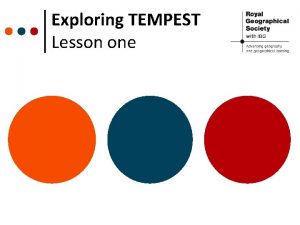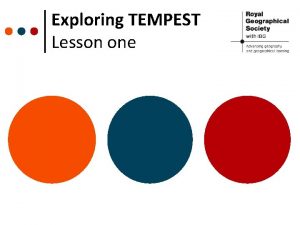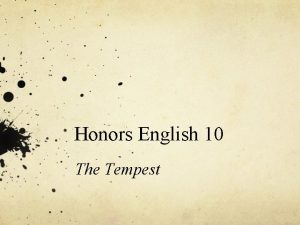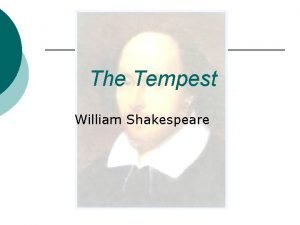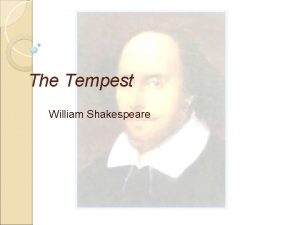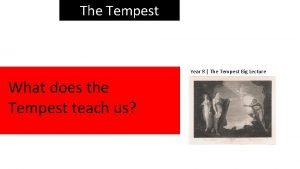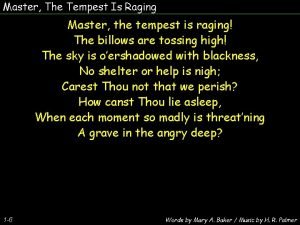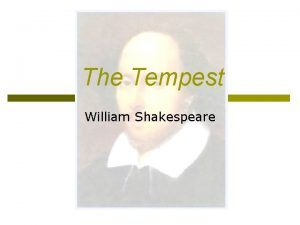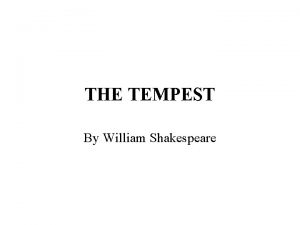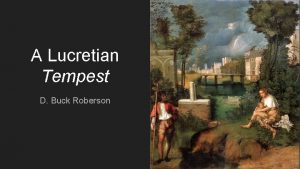Honors English 10 The Tempest The Tempest in



















- Slides: 19

Honors English 10 The Tempest

The Tempest in context The Tempest alludes to the shipwreck of the Sea Venture on Bermuda (1609), which resulted in the crew and passengers spending nine months in Bermuda, during which time one faction attempted mutiny.

History Tempest was probably written in the later part of 1610 or 1611; it was acted before King James on Nov. 1, 1611. The plot of the play appears to be wholly Shakespeare's invention; he used no direct historical sources. In May 1609, nine ships carrying 500 colonists set sail from England to reinforce the settlers at the colony of Jamestown in the New World, in what is now Virginia. In a storm, the ships were driven to the Bermudas, where a number of the travelers were stranded for nearly a year.

History Shakespeare almost certainly knew of the controversy surrounding the ownership of Virginia. Some argued that the natives settled in Virgina owned the land, and that European settlers had no right to take it from them. The Tempest gives both sides of the controversy. Shakespeare makes Caliban's claim to the island plausible, but also shows him as depraved; and the "colonists" have among them good men along with drunkards and murderers.

Themes The Tempest addresses all of the usual themes found in Shakesperian comedies: guilt and repentance; the finding of the lost; forgiveness; the renewal of the world; and the benevolence of unseen powers. ALSO: characters in the play have symbolic value, and that many of their actions are related to the idea of control.

Theme The Tempest concerns itself with those human achievements that result from control of the imagination, producing works of art which have at their strongest a power of transfiguration, a fresh revelation of the wonder of creation. The power of imagination is emphasized by its relationship to memory. Shakespeare returns to illusion vs. reality. He is performing a balancing act of opposites, and he uses the spectacle and the illusions to heighten the tensions between them

Theme The romance element of the play, as a whole, is countered by the moral seriousness of the play. There is a balancing of desire against virtue, lust against love, and discipline against passion--in all things, not just for the lovers

Character Prospero Magical, wonderful ruler of all. He has been exiled on the island with his daughter, Miranda He is partly dependent on Fortune, and partly master of it He is human, but has superhuman powers and is the “controlling agent” of the play. He creates a sense of mystery and awe.

Character Miranda Prospero’s young, beautiful naïve daughter She is the perfect audience for her father: Open Minded, willing to be impressed, full of wonder, She is eager to believe in all that she meets. Her innocence is full of pathos --- is she not as beautiful as she appears. Her innocence, but mature wisdom are both part of the truth and create a harmony that doubles the effect of each.

Caliban He is the symbol of all that is wrong with Colonialism Used as a tool to show contrasts: Childish, yet gruesome Emotional, yet aloof and outcast Savage yet traditional He is measured for art and civilization Also a stark contrast from Ferdinand, who swears he will not let lust overcome his honor.

Shakespeare’s Method He balances comic and serious and creates analogies which are unified through similar ideas “Delicate” used for Ariel, weather and air “Earthy” for Caliban Confusion between waking and sleep The Play moves from storm to calm; through punishments and restorations of faith But the overriding metaphor is CHANGE

Change All is changed or transformed. Ariel speaks of it and has physical transformation The maturity and loss of innocence that is shown through Miranda Caliban, reveals this thread by the fact that he CAN’T change, yet words like “dissolve”, “fade” and “blend” are common. Shakespeare uses all of this transition of things side by side to show with simpler feeling that man’s life is an illusion or a dream….

Summary of Intro Prospero is often seen identified as Shakespeare as A harassed overworked person of import One who is constantly aware of how much “time” is left A man who sees that all that he thought was real and good can change with Fate’s whim The play asks us to consider what we know to be true about our lives, through character, through love and lust, through moral exploration and through the politics of change.

Post-Colonial Theory & The Tempest During the 15 th Century until the 19 th Century (1400 s-1800 s) Europe began its first colonial wave. The earth was being “discovered” and there were myths about the “cannibals” of the Carribean, and distant utopias

Post-Colonial Theory & The Tempest With Caliban, Shakespeare may be offering an in -depth discussion into the morality of colonialism. Caliban is also shown as one of the most natural characters in the play, being very much in touch with the natural world

Post-Colonial Theory & The Tempest This new way of looking at the text explored the effect of the coloniser (Prospero) on the colonised (Ariel and Caliban). Ariel is generally viewed by scholars as the good servant, in comparison with the conniving Caliban—a view which Shakespeare's audience may well have shared.

Post-colonial theory in The Tempest Aspects of colonialism: Europeans’ appropriation of and exploitation of foreign territories Europeans’ subordination of indigenous populations (such as the different treatment of Caliban and Ariel) Europeans’ claims that they are colonizing to bring Christianity and civilization (Prospero’s taking credit for the fact that he has taught Caliban how to speak and the fact that he has liberated Ariel)

Post-colonial theory in The Tempest Caliban has been ensalved, as was the case of native people being "colonized" by conquering nations. He does not realize that his own choice of leader could be just as destructive. Post-colonial Africa is dealing with this still, having ousted nations of Europe only to find themselves in civil war…. Comfort exceeds freedom.

Colonizing Caliban More important than the emphasis on the way in which Caliban seems to others more monster than man, is the way Act I dramatizes the initial encounter between an almost completely isolated, “primitive” culture and a foreign, “civilized” one.
 English 2 honors vocabulary unit 1
English 2 honors vocabulary unit 1 Creighton honors program
Creighton honors program Aces james scholar
Aces james scholar Deped order no. 36 s. 2016
Deped order no. 36 s. 2016 Frap ucsb
Frap ucsb Honors physics semester 1 review
Honors physics semester 1 review Honors biology ecology test
Honors biology ecology test Economics 4.05 uncle sam's toolbox honors
Economics 4.05 uncle sam's toolbox honors Honors geometry quadrilaterals test
Honors geometry quadrilaterals test Honors earth science
Honors earth science Kuei honors chemistry
Kuei honors chemistry Honors math 3
Honors math 3 Hilton honors military program
Hilton honors military program Honors project
Honors project Honors biology properties of water lab
Honors biology properties of water lab Honors geometry parallel lines and transversals worksheet
Honors geometry parallel lines and transversals worksheet Tulane honors program
Tulane honors program Second quarter exam
Second quarter exam Precalculus honors chapter 1 test
Precalculus honors chapter 1 test Vyi physics
Vyi physics

















